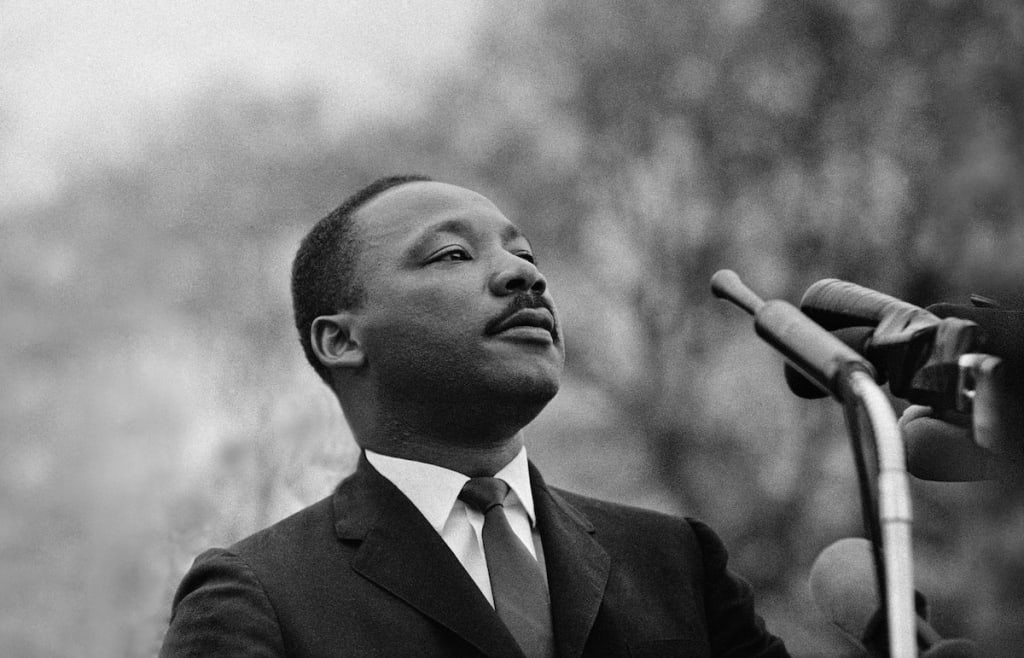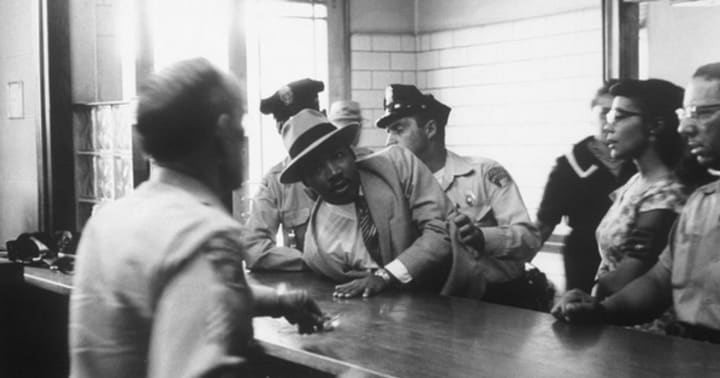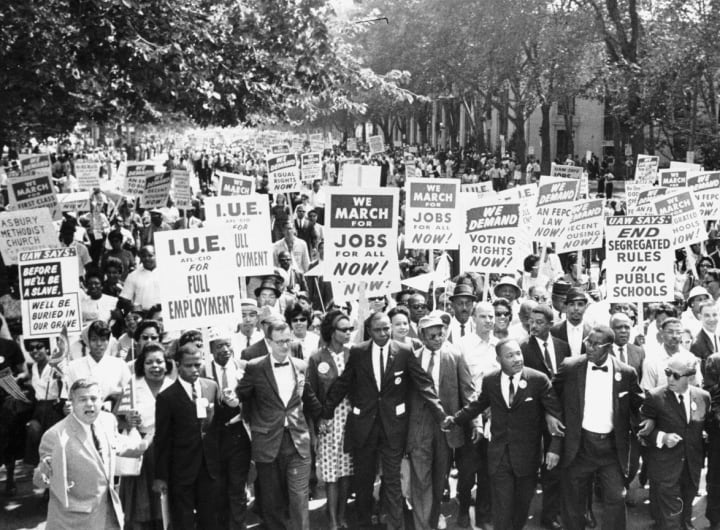1968: The Assassination of Martin Luther King Jr.
In the early 1960s, progress on civil rights was moving at a snail's pace but the divide was gradually crumbling thanks to the effort of Dr. King by bridging the gaps between races.

There is no figure more celebrated in the work he did for civil rights than Martin Luther King Jr. His death on April 4, 1968, due to an assassin’s bullet, left the nation and especially the black community hopeless.
Dr. Martin Luther King Jr. first made waves by assembling the 1955 Montgomery bus boycotts which were put together after Rosa Parks was arrested for refusing to move further back on the bus for a white passenger. At the time, Jim Crow laws prevented African Americans from being hired as drivers, forced them to enter and ride in the back of the bus, and were ordered to give up their seats for white passengers. This campaign lasted for a year until the United States Supreme Court deemed Alabama and Montgomery bus laws unconstitutional.
The next set of protests were the sit-ins of the early 1960s, organized by the Southern Christian Leadership Conference (SCLC), in which King was newly named the president. The SCLC and other black civilians of Birmingham, Alabama began to occupy public spaces, hold peaceful marches, and sit at white lunch counters to protest the unjust laws of the South.

The rules for the sit-ins were simple; sit quietly and wait to be served. Most times, participants were pelted with food and had to endure beatings by sitting at the all-white lunch counters. If any students were to retaliate, it would undermine the entire protest.
Progress on civil rights was moving at a snail's pace but the divide between races was gradually crumbling.
After establishing a working relationship with both the president, John F. Kennedy, and the attorney general, Robert Kennedy, King helped organize the March on Washington for Jobs and Freedom. A. Philip Randolph and Bayard Rustin originally brought up the idea for a march on the nation’s capital in 1961. After no signs from the White House of progress on civil rights that were promised in 1960 and plenty of time to plan for this massive event, the march was put in place.

On August 28, 1963, 100 years after the Emancipation Proclamation was signed by Abraham Lincoln, the March on Washington for Jobs and Freedom took place. Including speeches from John Lewis and Whitney Young, over 200,000 people showed up from all over the country to march from the Washington Monument to the Lincoln Memorial. The most memorable speaker of the day was, of course, Dr. King, who delivered his famous “I Have a Dream” speech in which he called for the end of racism.
The March on Washington for Jobs and Freedoms led to President Kennedy to address the nation on civil rights and put a plan in place to get a civil rights bill passed. By 1964, the Civil Rights Act of 1964 was passed under the Johnson administration.
King won the Noble Peace Prize in 1964 for his work combating racial inequality while doing so in a non-violent way. In 1965, he began organizing the Selma Voting Rights Movement. The Selma to Montgomery marches were three protest marches held in 1965 along the over 50-mile stretch of highway from Selma, Alabama to the state capital of Montgomery. The marches were meant to be non-violent protests to demonstrate the desire of African-American citizens to exercise their right to vote.
The first of the marches took place in March 1965 when state troopers attacked demonstrators with tear gas and billy clubs as they crossed the county line. The bloodshed led to an outcry from civil rights leaders and many across the nation for allowing something like this to happen. The Selma Voting Rights Movement would pave the way for the passage of the Voting Rights Act later that year.
By 1968, King along with the rest of the nation had moved their focus towards ending the Vietnam War. Passionate that the unnecessary violence happening in Southeast Asia needed to be stopped, he addressed the president multiple times about the war.
On March 29, 1968, King visited Memphis, Tennessee in support of the black sanitary public works employees that had been on strike since March 12 for higher wages and equal opportunity. On April 3, King addressed a crowd and delivered his infamous “I’ve Been to the Mountaintop” speech. In the last speech he would ever give, King would say:
“Well, I don't know what will happen now. We've got some difficult days ahead. But it doesn't matter with me now. Because I've been to the mountaintop. And I don't mind. Like anybody, I would like to live a long life. Longevity has its place. But I'm not concerned about that now. I just want to do God's will. And He's allowed me to go up to the mountain. And I've looked over. And I've seen the promised land. I may not get there with you. But I want you to know tonight, that we, as a people, will get to the promised land. So I'm happy, tonight. I'm not worried about anything. I'm not fearing any man. Mine eyes have seen the glory of the coming of the Lord.”
At 6:01 PM, on April 4, King was fatally shot by James Earl Ray as he stood on the second-floor balcony of the Lorraine Motel. King died at 7:05 PM at the age of 39-years-old.
Multiple riots broke out in almost every major city across the United States after the news broke of King’s death. Robert Kennedy, campaigning for the Democratic Party’s presidential nomination at the time, was in Indianapolis the night Dr. King was shot and killed. He proceeded to make one of the greatest and most heartfelt speeches ever given:
“Martin Luther King dedicated his life to love and to justice between fellow human beings. He died in the cause of that effort. In this difficult day, in this difficult time for the United States, it's perhaps well to ask what kind of a nation we are and what direction we want to move in. For those of you who are black—considering the evidence evidently is that there were white people who were responsible—you can be filled with bitterness, and with hatred, and a desire for revenge.We can move in that direction as a country, in greater polarization—black people amongst blacks, and white amongst whites, filled with hatred toward one another. Or we can make an effort, as Martin Luther King did, to understand, and to comprehend, and replace that violence, that stain of bloodshed that has spread across our land, with an effort to understand, compassion, and love.”
Over a hundred cities across the United States burned that night; Indianapolis was not one of them.
A sense of mourning was draped across the country, one that felt as deep as it did in 1963 with the death of President Kennedy. King’s legacy continues to live on. He is a hailed figure from the 20th century and rightly so. Despite 50 years since his death, civil rights have had many major accomplishments but there is still enormous room to grow. Police brutality towards innocent black civilians took centre stage in 2013 with the Black Lives Matter movement. With the way the current administration has governed, where bigotry and hatred reign supreme, it’s time to take a page from King’s book.
Watch the third part of a six-part series about 1968 here:
About the Creator
Shandi Pace
History lover, music nerd and sports fanatic. | Instagram & Twitter: @shandipace, YouTube: https://www.youtube.com/shandipace






Comments
There are no comments for this story
Be the first to respond and start the conversation.